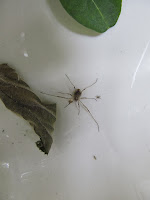If you have been following my adventures you will know that I recently did a two week stint at RSPB Forsinard reserve. Shortly after I returned I received an invitation to the RSPB Volunteer Day in Stirling, which was nice! It was held in the university and comprised of a main hall featuring stands from BTO, iSpot, Butterfly Conservation, Marine Conservation Society and various reserves.
The day began with a welcome talk by the director, Stuart Housden, where success stories were shared and the RSPB's change in focus was outlined (as you may have seen in the recent advertising campaign 'Give Nature a Home'). The change in image is a lot to do with the importance of conserving ecosystems and biodiversity within them rather than just focusing on key species. The RSPB have had this wider approach for quite a while however the general public tend still to think 'birds' when someone mentions the name, rather than all of nature. There is evidence that these perceptions are changing, which is brilliant of course, and also the knowledge that organisations such as RSPB are working alongside other conservation charities large and small for the benefit of nature.
There were a series of workshops available in the morning and afternoon, and I prebooked on Owl Pellet Dissection just before lunch (!) and RSPB Loch Lomond in the afternoon. I have picked apart owl pellets before but was keen to go into a bit more detail and find out what species the various bones inside belonged to. For those who can't tell puke from poo - pellets are the regurgitated remains of a bird's meal, which can include indigestible parts such as bones, claws, fur and feathers. In the gizzard the rest of the fleshy parts are dissolved by acidic juices and digested, the remains are then thrown back up around 6 hours after the meal has been eaten. They are often found around favourite perches near fenceposts or barn doors etc.
Our pellets had been presoaked to make it easier to pull out small bones. They were also crawling with clothes moth larvae and pupae to make it even more fun :) As you pull the dark mass apart you immediately start to see skulls, both intact and in bits, mandibles and then larger leg bones such as the femur, then working down to rib bones and finally tiny tarsus and metatarsus.
 |
| Apologies for the rubbish phone photo |
In my pellet there were a couple of field vole (a rodent) skulls along with 3 common shrew skulls! You can tell the shrew by it's wedge-shaped cranium and sometimes you can see the tips of the jagged insectivorous teeth are red in colour. One vole tooth was able to be pulled out of the lower jaw and it was almost the length of the entire jaw itself! This is due to rodents wearing down their teeth gnawing on things and so they need to grow continuously.
We also got to take some dried pellets home so I gave them to R as a present.
Here's a good guide for identifying small bones
After a free lunch (heyhey!) it was time for the second workshop which involved learning about the latest site acquired by the RSPB at
Loch Lomond. This site is being viewed as a clean slate and so the staff were looking for ideas from volunteers on what sort of things we would expect to see and want at a reserve. There were three tables each with a different topic each: Wildlife Watching, Volunteering and I forget the third and after a bit of discussion we wrote down our contributions, swapped round and noted if we agreed with the other groups suggestions and added our own. It was quite amusing as most of the volunteers were of the older variety and some of the suggestions were quite stereotypical :)
To round off the day there were a few talks on the All Nature programme, bird monitoring and reserves in the east of Scotand. Unfortunately I had to leave after the first one but managed to hear all about the bugs so I was happy enough! I'm hoping to visit the site of the new reserve and check it out, and maybe someday when it's open I can volunteer there.
















